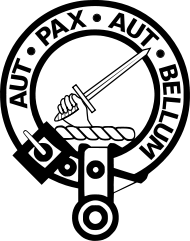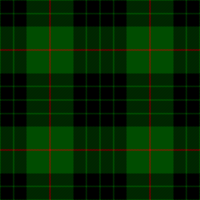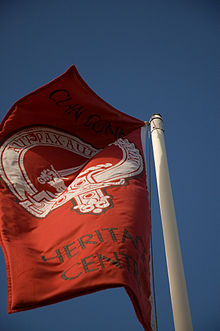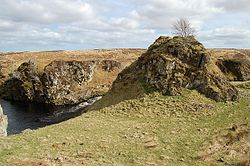- Clan Gunn
-
Clan Gunn Crest badge 
Motto: Aut Pax Aut Bellum; translated literally as "Either peace or war", colloquially translated as "In peace and war" or, alternatively, with the raised sword of the crest, as "Stand ready for peace or war." Slogan: Clyth Profile Plant badge Juniper Pipe music "The Gunn's Salute" Gaelic name Guinne (Surname) Chief Clan Gunn has no chief, and is an armigerous clan Historic seat Clyth Castle (Castle Gunn)
Dirlot Castle
Halberry CastleSepts of Clan Gunn Jameson, Jamieson, Jamison, Jaisson, MacHamish, Mackeamish, Robson, Robeson, Robison, Robinson, MacRob, Johnson, MacIan, MacCorkill , MacCorkle, Will, Wilson, MacWilliam, Williamson, Sandison, Henderson, Enrick, Inrig, Eanrig, Mann, Manson, Manus, Magnus, Georgeson, Gaunson, Ganson, Gallie, Nelson, Neilson, Swanson, Korman Allied clans Clan Sutherland
Clan Mackay (18th century)Rival clans Clan Keith
Clan Mackay (15th & 16th century)Clan Gunn is a Scottish clan associated with northeastern Scotland, including Caithness and Sutherland as well as the Orkney Islands.The clan's origins stretch over the sea to Norway, and the Clan Gunn themselves claim descent from the legendary viking Sweyn Asleifsson, the progenitor of the clan, and through his grandson Gunni, considered to be the "namefather" of Clan Gunn. The clan is an armigerous clan, without a chief, so the Lord Lyon has recognized a clan commander.
Contents
History
Origins
It is believed that a member of Clan Gunn was among the party of Henry Sinclair, a Scottish Earl whom some believe to have made a voyage to the New World in 1398, traveling to Nova Scotia and New England. This individual is believed to have perished on this expedition and is also known as the Westford Knight. Often, it is claimed by enthusiasts devoted to this tale that the knight is Sir James Gunn, who reportedly traveled with Sinclair. There is no documentary evidence to support this theory.
15th century and clan conflicts
The origin of the name Gunn is Norwegian. The word "Gunni" in the Old Norwegian language means "War" or "Battle". The Battle of Harpsdale was fought in 1426. The Clan Gunn fought an inconclusive battle with the Clan Mackay.[1]
The Battle of Tannach was fought in 1464. It was fought between the Clan Keith, assisted by the Clan Mackay against the Clan Gunn. The inhabitants of Caithness assembled an army and met the Mackays and Keiths at a place in Caithness called Blair-tannie. There ensued a cruel fight, with slaughter on either side. In the end the Keiths and Mackays had the victory by means chiefly of John Mor MacIan-Riabhaich (an Assynt man), who was very famous in these countries for his courage shown at this conflict. Two chieftains of Caithness were slain. Angus Mackay would later be defeated by Clan Ross.[2][3]
The Battle of Champions was fought in 1478 between twelve men of the Clan Gunn and twenty four men of the Clan Keith where the chief of Clan Gunn was killed (reputedly, the agreement was for "twelve horse" of each clan to meet and parley, and the Keiths arrived with two men on each horse). The chief of the Clan Keith was also soon after killed by the Gunns in a revenge attack at the chapel of St. Tears.[4]
In later years William MacKames Gunn, grandson of George Gunn, ambushed chief George Keith, his son and ten of their retainers as they were traveling at Drummoy in Sutherland. All of the Keiths were killed by the Gunns. It was around this time a large majority of the Gunns, under James Gunn, removed from Caithness into Sutherland.[5]
16th century and clan conflicts
In 1517 the Clan Gunn supported the Clan Sutherland in defeating the Clan Mackay at the Battle of Torran Dubh.[6]
Alistair Gunn, son of John Robson Gunn, chief of the clan, had become a man of much note and power in the North. He had married the daughter of John Gordon the Earl of Sutherland and for this reason "he felt entitled to hold his head high amongst the best in Scotland". His pride, or perhaps his loyalty to the Earl of Sutherland, led to his undoing when in 1562, he led Gordon's retinue and encountered James Stewart, Earl of Moray, and his followers on the High Street of Aberdeen. The Earl was the bastard half-brother of Mary, Queen of Scots, as well as the son-in-law of William Keith, 4th Earl Marischal, the head of Clan Keith. It was the custom at the time to yield thoroughfares to the personage of greater rank, and in refusing to yield the middle of the street to Stewart and his train, Alistair publicly insulted the Earl. Stewart soon afterwards had him pursued to a place called Delvines, near Nairn. There he was captured and taken to Inverness, and following a mock trial, he was executed.[7]
In 1586 at the Battle of Allt Camhna the Clan Gunn was victorious but they were defeated shortly afterwards by a massive force at the Battle of Leckmelm.[8]
17th century and Civil War
The most notable of the Gunns after the differentiation of the Clan was Sir William Gunn, who fought under Charles I, and was knighted by him. After Charles' cause failed, William crossed to Europe, and served in the army of the Holy Roman Empire, became an imperial general and married a German baroness. Much of the clan, however, had to forfeit their lands due to debt at about this time. The Gunns of Killearnan were fortunate enough to obtain new land at Badenloch.
18th century and Jacobite uprisings
Unlike some highland clans, the Gunns did not rise under the standard of the Stuarts during the Jacobite rebellions, and indeed supported the government in the conflict of 1745 along with other Highland clans such as Clan Munro, Clan Campbell, Clan Mackay, Clan Sutherland and Clan Ross. The Clan Gunn came out for the government, led by the MacKeamish. There were about 120 men under arms. They were attached to the Earl of Loudon's regiment.
Modern history
The eighth MacKeamish, who was William Gunn, son of Alexander of Badenloch, was killed fighting in India in 1780. Upon his death the chiefship passed to his brother, Morrison Gunn, the ninth MacKeamish, who was also serving with the British army. Unfortunately Morrison died in Gibraltar in 1785 before he could assume the office of chief in any meaningful way. Both these chiefs died without issue, resulting in the extinction of the direct male line of Donald Crotaich, the sixth MacKeamish. Some confusion was created in 1803 when the Countess of Sutherland, on whose lands the remnants of the clan resided at the time, decided that the heir to the chiefship should be found.
A sheriff’s court was held on 31 May 1803 in Thurso to hear arguments from various claimants. The jury at this court finally decided that Hector Gunn, great grandson of George Gunn of Borrobol, the brother of the sixth MacKeamish, was heir male, which he was. However, they or someone else then proceeded to declare him chief of the clan, which they had no authority to do, as this decision could only be made by the Lyon Court when genealogical questions exist, and the Corrish Gunns had a rival claim at the time of the sheriff's court. There is no record that the Lord Lyon was consulted in the matter. Hector died almost immediately afterward. Hector’s son, George, was a protégé of the Countess, who had purchased a commission for him in the Royal Marines. In 1814, George was declared chief by someone, nobody seems completely sure who, but it was not the Lyon Court. It is probable that he simply assumed the role of chief due to the erroneous belief that his father was chief. It is doubtful that George Gunn of Rhives (Rhives being the estate given to him by the Countess, who appointed him as an under factor at Assynt and later head factor at Dunrobin) was ever accepted as chief by many of the clan.
The end of the clan system in 1746 had removed most feelings of loyalty and even kinship to the chief amongst the Highland clans, and the Clearances (forced removal from their lands) had created bitterness toward anyone in authority. Gunn of Rhives died in 1859 and his two sons not long after. The fact is that neither Hector nor George were legally chief of the clan because they were not declared so by the Lyon Court, in spite of their apparent descent from the brother of Donald Crotach, George Gunn of Borrobol. However, the story of their appointments to be chief has crept into authoritative works without a nod toward the legality of it. In legal terms, the office of chief of the Clan Gunn became vacant with the death of Morrison Gunn in 1785 and remains vacant today, although an heir, through the female line, was identified almost ten years ago. The heir to the chiefship, William Sinclair Gunn of Inverness, died in the spring of 2009. He has a son who has expressed some interest in the office, but to date has made no effort to be named chief. The clan continues to be ably led by an appointed clan commander, Iain Alexander Gunn Of Banniskirk.
Present day
Today, the Gunns are a widespread family with roots at home, Canada, the US, New Zealand, Australia, United Kingdom and around the globe. This is attributed to the diaspora that took place during the Highland Clearances in Caithness and Sutherland. If you visit today you can see the old crofts that were burned at this time. Efforts have been made to reunite the Clan with societies in North America, New Zealand, Australia and Scotland. A museum of the Clan's history has also been established at Latheron in Caithness.
In 1978, following efforts by American members of both clans, the Commander of Clan Gunn and the Chief of Clan Keith signed a "Bond and Covenant of Friendship" officially ending the feud between their respective clans. The treaty was signed at the site of the battle of St. Tears five hundred years before, and is celebrated by members of both clans at Highland games and other Scottish cultural gatherings wherever they meet. It has become a tradition amongst Gunn families to name their first son "Keith" in honor of this treaty, although in modern times, it is more commonly used as a second or even third name.
Castles
- Dirlot Castle: - OS map reference ND 126486.
The base of a small tower, built either by the Cheynes in the 14th century or the Gunns in the 15th century, lies on a rock above the river Thurso in a lonely position far inland. On the summit of a crag by the western bank of the River Thurso in a remote and barren area south of Halkirk, are foundations of a tower built by Donald Cheyne. It measures 9.5 m by 6.5 m with walls 1.6 m thick. It had a courtyard on the south-east, measuring 13 m by 7 m, which had only a parapet to defend it. In 1464, Dirlot was held by George, chief of the Gunn clan, but it was held by Alexander Sutherland at the time of his execution in 1499, for killing Alexander Dunbar. The castle was subsequently granted to the Clan Mackay by King James IV of Scotland.
- Clyth Castle or "the Gunn’s Castle": - OS map reference ND 307386.
In a difficult to access site on a rock by the shore are the foundations of a tower built about 1500 by the Gunns. A rock which is almost an island at high tide has sheer cliffs on all sides except to the west, where there is a steep slope up from the beach. At the summit was a wall near the remains of which are footings of a tower house, measuring 11.3 m by 7 m, with walls about 1 m thick.
- Halberry Castle: - OS map reference ND 302377.
At the neck of a coastal promontory is the base of the 15th century tower house of the chief of the Gunns. This site has a long narrow sea inlet isolating it from higher ground on the mainland. Across the neck is a ditch, 10 m wide and 2 m deep, which presumably once had an inner wall or bank and stockade. Close behind the ditch are grass-covered foundations of a tower house, measuring 13.5 m by 8.3 m. It was probably in existence by the mid 15th century, when George, chief of the Gunn clan had a residence there.[1]
Commander
Iain Alexander Gunn of Banniskirk was appointed Commander of Clan Gunn, by commission of Lord Lyon on 9 June 1972.[9]
Coat of Arms
There are no arms for Clan Gunn. In Scotland arms are granted to individuals, not families. No arms for a chief of Clan Gunn have been located in any registry of arms in Great Britain. This would seem to indicate that the term "armigerous" is wrongly applied to the Clan Gunn, assuming the presence of chiefly arms is the criteria for being so-named. The Lyon Court identified William Sinclair Gunn of Inverness as the heir to the chiefship of Clan Gunn several years ago. Unfortunately he died in 2009 without taking any meaningful steps to become chief. His son has expressed interest but he has not made any attempt to petition the Lyon Court as of this writing. If W. S. Gunn's son petitions to be named chief and is, then the Lyon Court will design his arms at that time.
A coat of arms was noted by Robert Ronald McIan in his The Clans of The Scottish Highlands, published in London by Ackermann and Co., 1845;
- "The coat armour is arg., a galley of three masts, sails furled and oars in action, sab., displaying at the mast-head, flags, gu., within a bordure az. On a chief of the third, a bear's head of the first, muzzled of the second, between two mullets of the field."
We do not know whose arms Mr. Logan, the author of the text of this book, is describing. It is certain that they were not the arms of the Chief of the Clan Gunn, as no such arms have been found, nor was there a chief in 1845. R. R. McIan was the illustrator of The Clans of The Scottish Highlands, but the text was the work of Mr. James Logan, though the book is billed as belonging to McIain. The work is fanciful in many ways, as Victorian "histories" tended to be at times.
Noted genealogist, the late Sir Iain Moncreiffe of that Ilk, speculated in his work, The Highland Clans, that the undifferenced arms of the Gunn chief would be described as follows: "Gules a lymphad, sails furled, oars in saltire, and in chief a mullet Gold between two buckles Silver."
Tartan
The Gunn tartan is found in 'weathered', 'ancient', 'muted', and 'modern' colorings. [A picture of the Tartan;[2]
In popular culture
- In Canadian author Margaret Laurence's 1974 novel The Diviners, the lead character Morag Gunn grows up with her uncle telling stories of the bravery of the Clan Gunn.
- In Robert Louis Stevenson's novel Treasure Island, Ben Gunn is a marooned pirate who resides on Treasure Island.
References
- ^ "Genealogical History of the Earldom of Sutherland". p.63 - 64, by Sir Robert Gordon (1580 -1656).
- ^ "Genealogical History of the Earldom of Sutherland". p.69. by Sir Robert Gordon.
- ^ ” The Guns” by Thomas Sinclair. 1890. Page 8.
- ^ "History of the House and Clan of the Name Mackay (1829). P.82 by Robert Mackay. Quoting "Genealogical History of the Earldom of Sutherland" by Sir Robert Gordon (1580 - 1656).
- ^ ” The Guns” by Thomas Sinclair. 1890. Page 9 and 37.
- ^ ” The Guns” by Thomas Sinclair. 1890. Page 36.
- ^ Clan Gunn history Electric Scotland.
- ^ "Genealogical History of the Earldom of Sutherland" .p.183. By Sir Robert Gordon (1580 - 1656).
- ^ Chiefship of Clan Gunn Clan Gunn Society.
External links
- Clan Gunn Society UK
- Clan Gunn UK
- Clan Gunn Australia Society
- Clan Gunn Society of North America
- Clan Gunn Society of North America - Eastern Canada Branch
- Early History of Clan Gunn & Septs
- Gunn DNA Project
- Gunn @ ElectricScotland
- The Clearance village of Badbea; by a Gunn descendant
Scottish clans Clans with chiefs Agnew · Anstruther · Arbuthnott · Arthur · Bannerman · Barclay · Borthwick · Boyd · Boyle · Brodie · Broun · Bruce · Buchan · Burnett · Cameron · Campbell · Carmichael · Carnegie · Cathcart · Charteris · Chattan · Chisholm · Cochrane · Colquhoun · Colville · Cranstoun · Crichton · Cumming · Darroch · Davidson · Dewar · Drummond · Dunbar · Dundas · Durie · Elliot · Elphinstone · Erskine · Farquharson · Fergusson · Forbes · Forsyth · Fraser · Fraser of Lovat · Gayre · Gordon · Graham · Grant · Gregor · Grierson · Guthrie · Haig · Haldane · Hamilton · Hannay · Hay · Henderson · Home · Hope · Hunter · Irvine · Jardine · Johnstone · Keith · Kennedy · Kerr · Kincaid · Lamont · Leask · Lennox · Leslie · Lindsay · Lockhart · Lumsden · Lyon · MacAlister · MacBain · MacDonald · Macdonald of Clanranald · MacDonald of Keppoch · Macdonald of Sleat · MacDonell of Glengarry · MacDougall · Macdowall · MacIntyre · Mackay · Mackenzie · Mackinnon · Mackintosh · Maclachlan · Maclaine of Lochbuie · MacLaren · MacLea (Livingstone) · Maclean · MacLennan · MacLeod · MacLeod of Lewis · MacMillan · Macnab · Macnaghten · MacNeacail · MacNeil · Macpherson · MacTavish · MacThomas · Maitland · Makgill · Malcolm (MacCallum) · Mar · Marjoribanks · Matheson · Menzies · Moffat · Moncreiffe · Montgomery · Morrison · Munro · Murray · Napier · Nesbitt · Nicolson · Ogilvy · Oliphant · Primrose · Ramsay · Rattray · Riddell · Robertson · Rollo · Rose · Ross · Ruthven · Sandilands · Scott · Scrymgeour · Sempill · Shaw · Sinclair · Skene · Spens · Stirling · Strange · Stuart of Bute · Sutherland · Swinton · Trotter · Urquhart · Wallace · Wedderburn · Wemyss · Wood ·
Armigerous clans Abercromby · Abernethy · Adair · Adam · Aikenhead · Ainslie · Aiton · Allardice · Anderson · Armstrong · Arnott · Auchinleck · Baillie · Baird · Balfour · Bannatyne · Baxter · Bell · Belshes · Bethune · Beveridge · Binning · Bissett · Blackadder · Blackstock · Blair · Blane · Blyth · Boswell · Brisbane · Buchanan · Butter · Byres · Cairns · Calder · Caldwell · Callender · Campbell of Breadalbane · Campbell of Cawdor · Carruthers · Cheyne · Chalmers · Clelland · Clephane · Cockburn · Congilton · Craig · Crawford · Crosbie · Cunningham · Dalmahoy · Dalrymple · Dalzell · Dennistoun · Don · Douglas · Duncan · Dunlop · Edmonstone · Fairlie · Falconer · Fenton · Fleming · Fletcher · Forrester · Fotheringham · Fullarton · Galbraith · Galloway · Gardyne · Gartshore · Ged · Gibsone · Gladstains · Glas · Glen · Glendinning · Gray · Gunn · Haliburton · Halkerston · Halket · Hepburn · Heron · Herries · Hogg · Hopkirk · Horsburgh · Houston · Hutton · Inglis · Innes · Kelly · Kinloch · Kinnaird · Kinnear · Kinninmont · Kirkcaldy · Kirkpatrick · Laing · Lammie · Langlands · Learmonth · Little · Logan · Logie · Lundin · Lyle · MacAulay · Macbrayne · MacDuff · MacEwen · MacFarlane · Macfie · Macgillivray · MacInnes · MacIver · Mackie · MacLellan · Macquarrie · Macqueen · Macrae · Masterton · Maule · Maxton · Maxwell · McCorquodale · McCulloch · McKerrell · Meldrum · Melville · Mercer · Middleton · Moncur · Monteith · Monypenny · Mouat · Moubray · Mow · Muir · Murray of Atholl · Nairn · Nevoy · Newlands · Newton · Norvel · Ochterlony · Orrock · Paisley · Paterson · Pennycook · Pentland · Peter · Pitblado · Pitcairn · Pollock · Polwarth · Porterfield · Preston · Pringle · Purves · Rait · Ralston · Renton · Roberton · Rossie · Russell · Rutherford · Schaw · Seton · Skirving · Somerville · Spalding · Spottiswood · Stewart · Stewart of Appin · Strachan · Straiton · Strange · Sydserf · Symmers · Tailyour · Tait · Tennant · Troup · Turnbull · Tweedie · Udny · Vans · Walkinshaw · Wardlaw · Watson · Wauchope · Weir · Whitefoord · Whitelaw · Wishart · Young
Culture and society Scotland · Clan chief · Septs · Clan badge · Clan crest · Clan battles · Tartan · Bagpipes · Clearances · Kilt · Manrent · The Highlands · Battle of Culloden · Highland games · Border Reivers · Scottish heraldry · Scottish surnames
Categories:- Scottish clans
- Armigerous clans
- Norse-Gaels
- Norse activity in Scotland
- Gaelic families of Norse descent
Wikimedia Foundation. 2010.



